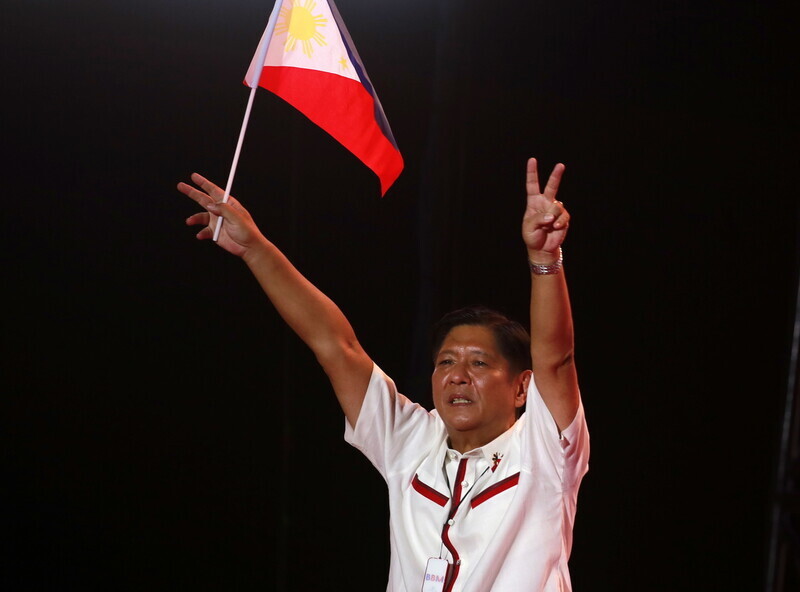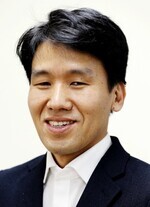hankyoreh
Links to other country sites 다른 나라 사이트 링크
[Column] How a dictator’s son reclaimed the helm of power


More than two million Filipinos poured onto the streets of Manila between Feb. 22-25, 1986, to demand the end of the 21-year-long Ferdinand Marcos regime and the return of power to the people. As a result of this People Power Revolution, Marcos and his family had to flee to Hawaii and the Marcos dynasty seemed to have met its political downfall.
However, 36 years later, the controversial family seems back and stronger than ever. Ferdinand Marcos Jr., the 65-year-old son of the former dictator, won Monday’s presidential election in the Philippines by a landslide.
According to an unofficial count, 31 million out of 67 million voters cast their vote for him, more than doubling the share won by his rival, Vice President Leni Robredo.
Marcos Jr. was 23 years old in 1980 when his father ruled the Philippines through martial law. The young Marcos was also directly involved in politics as he became vice governor of the Ilocos Norte province, the political base of the family.
As to how he was able to succeed his father 36 years later, a major factor is that he and his supporters were able to convincingly rebrand Marcos Sr.’s regime as the “golden age of the Philippines” — rather than a period of human rights oppression under dictatorship and illegal excess.
Posts describing the Marcos regime as a beautiful time have been circulated throughout Philippine social media in recent years. Many also shared articles claiming that the Philippines was the second richest country in Asia after Japan during the Marcos regime. Of course, this was not true.
In 1965, the first year of Marcos Sr.’s rule, the Philippines’ gross domestic product was Asia’s seventh-largest, and the economy was growing. In the first half of his reign, Marcos tried to speed up economic growth by bringing in foreign loans and investing in the construction of social infrastructure.
The economic growth rate reached 8.8% in 1976 due to such investment and the effects of rising global raw material prices. However, due to corruption, investment in infrastructure did not have the desired effects and the Philippine economy contracted by 7.3% in both 1984 and 1985, during the second half of the Marcos regime. This was because of a surge in foreign debt and a result of the boom in raw materials dying down.
Although the Philippine economy was not weak throughout the Marcos era, it’s difficult to call the time a “golden age.”
Marcos Jr. actively used articles and videos emphasizing investment in infrastructure during his father's time in power on social media, but avoided participating in presidential debates.
The age group made up of those aged 18-41, which accounts for more than half of the Philippine electorate, has little memory of the Marcos dictatorship. Because of this, promoting the Marcos family in a good light, mainly through social media, has been quite effective.
But Marcos Jr.’s overwhelming victory was not solely due to his smart use of social media. If many of the older generation who remember the People Power Revolution had not voted for Marcos, he would not have been able to win the presidential election with such overwhelming numbers.
Even after the revolution, dynastic politics and the extreme gap between rich and poor, a chronic problem in the Philippines, remained fundamentally unresolved.
According to World Bank statistics (as of 2018), the Gini coefficient, which indicates the degree of income inequality between classes in a society, was 0.42 in the Philippines. This is higher than those in neighboring Southeast Asian countries like Thailand (0.36) and Indonesia (0.37). The closer to 0, the more equal a society is, while higher levels of inequality are measured closer to 1.
One of the reasons behind the advent of the Marcos Jr. regime is the expectation that a strong leader will emerge and solve these various, real problems for the local people.
President Rodrigo Duterte, who came from a political family in southern Mindanao and caused controversy with the numerous human rights abuses carried out in the name of his infamous war on drugs, also succeeded in taking power using similar tactics as Marcos Jr.
But is this a problem unique to the Philippines? This is why the news of the Philippines' presidential election should be looked at beyond eye-catching headlines.
Please direct questions or comments to [english@hani.co.kr]

Editorial・opinion
![[Column] Park Geun-hye déjà vu in Yoon Suk-yeol [Column] Park Geun-hye déjà vu in Yoon Suk-yeol](https://flexible.img.hani.co.kr/flexible/normal/500/300/imgdb/original/2024/0424/651713945113788.jpg) [Column] Park Geun-hye déjà vu in Yoon Suk-yeol
[Column] Park Geun-hye déjà vu in Yoon Suk-yeol![[Editorial] New weight of N. Korea’s nuclear threats makes dialogue all the more urgent [Editorial] New weight of N. Korea’s nuclear threats makes dialogue all the more urgent](https://flexible.img.hani.co.kr/flexible/normal/500/300/imgdb/original/2024/0424/7317139454662664.jpg) [Editorial] New weight of N. Korea’s nuclear threats makes dialogue all the more urgent
[Editorial] New weight of N. Korea’s nuclear threats makes dialogue all the more urgent- [Guest essay] The real reason Korea’s new right wants to dub Rhee a founding father
- [Column] ‘Choson’: Is it time we start referring to N. Korea in its own terms?
- [Editorial] Japan’s rewriting of history with Korea has gone too far
- [Column] The president’s questionable capacity for dialogue
- [Column] Are chaebol firms just pizza pies for families to divvy up as they please?
- [Column] Has Korea, too, crossed the Rubicon on China?
- [Correspondent’s column] In Japan’s alliance with US, echoes of its past alliances with UK
- [Editorial] Does Yoon think the Korean public is wrong?
Most viewed articles
- 1‘We must say no’: Seoul defense chief on Korean, USFK involvement in hypothetical Taiwan crisis
- 2N. Korean delegation’s trip to Iran shows how Pyongyang is leveraging ties with Moscow
- 3[Column] Park Geun-hye déjà vu in Yoon Suk-yeol
- 4Amnesty notes ‘erosion’ of freedom of expression in Korea in annual human rights report
- 5‘Weddingflation’ breaks the bank for Korean couples-to-be
- 646% of cases of violence against women in Korea perpetrated by intimate partner, study finds
- 7[Reportage] On US campuses, student risk arrest as they call for divestment from Israel
- 8“Parental care contracts” increasingly common in South Korea
- 9[Interview] Dear Korean men, It’s OK to admit you’re not always strong
- 10Korean government’s compromise plan for medical reform swiftly rejected by doctors